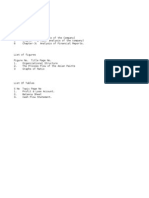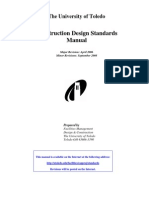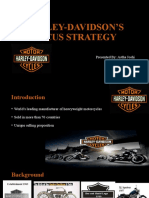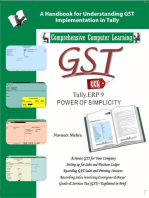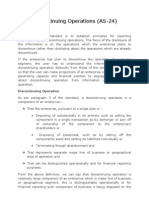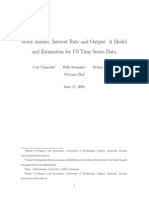100%(1)100% found this document useful (1 vote)
2K views7Ps of Banking Product
7Ps of Banking Product
Uploaded by
Dhirendra Singh Dhruv DsdICICI Bank is India's second largest bank, with over 1,500 branches and 4,800 ATMs. It offers a wide range of banking products and services to retail and corporate customers through multiple channels. These include deposits, investments, loans, cards, demat services, mobile and online banking, and NRI services. ICICI determines prices for its products based on regulatory guidelines as well as its own financial objectives and the risks associated with each product or service. It aims to establish prices that benefit both customers and the bank.
Copyright:
Attribution Non-Commercial (BY-NC)
Available Formats
Download as DOCX, PDF, TXT or read online from Scribd
7Ps of Banking Product
7Ps of Banking Product
Uploaded by
Dhirendra Singh Dhruv Dsd100%(1)100% found this document useful (1 vote)
2K views16 pagesICICI Bank is India's second largest bank, with over 1,500 branches and 4,800 ATMs. It offers a wide range of banking products and services to retail and corporate customers through multiple channels. These include deposits, investments, loans, cards, demat services, mobile and online banking, and NRI services. ICICI determines prices for its products based on regulatory guidelines as well as its own financial objectives and the risks associated with each product or service. It aims to establish prices that benefit both customers and the bank.
Original Title
7Ps of banking product
Copyright
© Attribution Non-Commercial (BY-NC)
Available Formats
DOCX, PDF, TXT or read online from Scribd
Share this document
Did you find this document useful?
Is this content inappropriate?
ICICI Bank is India's second largest bank, with over 1,500 branches and 4,800 ATMs. It offers a wide range of banking products and services to retail and corporate customers through multiple channels. These include deposits, investments, loans, cards, demat services, mobile and online banking, and NRI services. ICICI determines prices for its products based on regulatory guidelines as well as its own financial objectives and the risks associated with each product or service. It aims to establish prices that benefit both customers and the bank.
Copyright:
Attribution Non-Commercial (BY-NC)
Available Formats
Download as DOCX, PDF, TXT or read online from Scribd
Download as docx, pdf, or txt
100%(1)100% found this document useful (1 vote)
2K views16 pages7Ps of Banking Product
7Ps of Banking Product
Uploaded by
Dhirendra Singh Dhruv DsdICICI Bank is India's second largest bank, with over 1,500 branches and 4,800 ATMs. It offers a wide range of banking products and services to retail and corporate customers through multiple channels. These include deposits, investments, loans, cards, demat services, mobile and online banking, and NRI services. ICICI determines prices for its products based on regulatory guidelines as well as its own financial objectives and the risks associated with each product or service. It aims to establish prices that benefit both customers and the bank.
Copyright:
Attribution Non-Commercial (BY-NC)
Available Formats
Download as DOCX, PDF, TXT or read online from Scribd
Download as docx, pdf, or txt
You are on page 1of 16
7P’s of Marketing Mix of ICICI Bank
ICICI Bank is India’s second-largest
bank with total assets of Rs. 3,663.74 billion (US$
76 billion) at September 30, 2009 and profit after
tax Rs. 19.18 billion (US$ 398.8 million) for the half
year ended September 30, 2009. The Bank has a
network of 1,588 branches and about 4,883 ATMs
in India and presence in 18 countries. ICICI Bank
offers a wide range of banking products and
financial services to corporate and retail
customers through a variety of delivery channels
and through its specialised subsidiaries and
affiliates in the areas of investment banking, life
and non-life insurance, venture capital and asset
management. The Bank currently has subsidiaries
in the United Kingdom, Russia and Canada,
branches in United States, Singapore, Bahrain,
Hong Kong, Sri Lanka, Qatar and Dubai
International Finance Centre and representative
offices in United Arab Emirates, China, South
Africa, Bangladesh, Thailand, Malaysia and
Indonesia. Our UK subsidiary has established
branches in Belgium and Germany.
ICICI Bank’s equity shares are listed in India on
Bombay Stock Exchange and the National Stock
Exchange of India Limited and its American
Depositary Receipts (ADRs) are listed on the New
York Stock Exchange (NYSE).
History:
ICICI Bank was originally promoted in 1994 by
ICICI Limited, an Indian financial institution, and
was its wholly-owned subsidiary. ICICI’s
shareholding in ICICI Bank was reduced to 46%
through a public offering of shares in India in fiscal
1998, an equity offering in the form of ADRs listed
on the NYSE in fiscal 2000, ICICI Bank’s
acquisition of Bank of Madura Limited in an all-
stock amalgamation in fiscal 2001, and secondary
market sales by ICICI to institutional investors in
fiscal 2001 and fiscal 2002. ICICI was formed in
1955 at the initiative of the World Bank, the
Government of India and representatives of Indian
industry. The principal objective was to create a
development financial institution for providing
medium-term and long-term project financing to
Indian businesses. In the 1990s, ICICI transformed
its business from a development financial
institution offering only project finance to a
diversified financial services group offering a wide
variety of products and services, both directly and
through a number of subsidiaries and affiliates like
ICICI Bank. In 1999, ICICI become the first Indian
company and the first bank or financial institution
from non-Japan Asia to be listed on the NYSE.
After consideration of various corporate
structuring alternatives in the context of the
emerging competitive scenario in the Indian
banking industry, and the move towards universal
banking, the managements of ICICI and ICICI Bank
formed the view that the merger of ICICI with ICICI
Bank would be the optimal strategic alternative for
both entities, and would create the optimal legal
structure for the ICICI group’s universal banking
strategy. The merger would enhance value for
ICICI shareholders through the merged entity’s
access to low-cost deposits, greater opportunities
for earning fee-based income and the ability to
participate in the payments system and provide
transaction-banking services. The merger would
enhance value for ICICI Bank shareholders through
a large capital base and scale of operations,
seamless access to ICICI’s strong corporate
relationships built up over five decades, entry into
new business segments, higher market share in
various business segments, particularly fee-based
services, and access to the vast talent pool of
ICICI and its subsidiaries. In October 2001, the
Boards of Directors of ICICI and ICICI Bank
approved the merger of ICICI and two of its wholly-
owned retail finance subsidiaries, ICICI Personal
Financial Services Limited and ICICI Capital
Services Limited, with ICICI Bank. The merger was
approved by shareholders of ICICI and ICICI Bank
in January 2002, by the High Court of Gujarat at
Ahmedabad in March 2002, and by the High Court
of Judicature at Mumbai and the Reserve Bank of
India in April 2002. Consequent to the merger, the
ICICI group’s financing and banking operations,
both wholesale and retail, have been integrated in
a single entity.
7P’s of Marketing of ICICI Bank:
PRODUCT MIX:
1. DEPOSITS:
ICICI Bank offers wide variety of Deposit Products
to suit our requirements. Coupled with
convenience of networked branches/ over 1800
ATMs and facility of E-channels like Internet and
Mobile Banking, ICICI Bank brings banking at your
doorstep.
Savings Account: ICICI Bank offers a power
packed Savings Account with a host of convenient
features and banking channels to transact through.
Senior Citizen Services: The Senior Citizen
Services from ICICI Bank has several advantages
that are tailored to bring more convenience and
enjoyment in your life.
Young Stars: It’s really important to help children
learn the value of finances and money
management at an early age. Banking is a serious
business, but we make banking a pleasure and at
the same time children learn how to manage their
personal finances.
Fixed Deposits: Safety, Flexibility, Liquidity and
Returns!!!! A combination of unbeatable features of
the Fixed Deposit from ICICI Bank.
Recurring Deposits: Through ICICI Bank Recurring
Deposit you can invest small amounts of money
every month that ends up with a large saving on
maturity. So you enjoy twin advantages-
affordability and higher earnings.
Roaming Current Account: Only Roaming Current
Account from ICICI Bank travels the distance with
your business. You can access your accounts at
over 500 networked branches across the country.
Bank @ Campus: Thanks to bank@campus, child
can now surf the Net and access all the details of
his / her account at the click of a mouse! No need
to visit the bank branch at all.
ICICI Bank Salary Account: is a benefit-rich payroll
account for Employers and Employees. As an
organization, you can opt for our Salary Accounts
to enable easy disbursements of salaries and enjoy
numerous other benefits too.
2. INVESTMENTS
Along with Deposit products and Loan offerings,
ICICI Bank assists you to manage your finances by
providing various investment options such as:
• ICICI Bank Tax Saving Bonds
• Government of India Bonds
• Investment in Mutual Funds
• Initial Public Offers by Corporate
• Investment in “Pure Gold”
• Foreign Exchange Services
• Senior Citizens Savings Scheme, 2004
3. ANYWHERE BANKING
ICICI Bank is the second largest bank in the
country. It services a customer base of more than
5 million customer accounts through a multi-
channel access network. This includes more than
500 branches and extension counters, over 1800
ATMs, Call Centre and Internet Banking.
Thus, one can access the various services ICICI
Bank has to offer at anytime, anywhere and from
anyplace.
4. LOAN
a) Home Loans
b) Personal Loans
c) Car Loans
d) Two Wheeler Loans
e) Commercial Vehicle Loans
f) Loans against Securities
g) Farm Equipment Loans
h) Construction Equipment Loans
i) Office Equipment Loans
j) Medical Equipment Loans
5. CARDS
a) Credit Card
b) Debit cum ATM Card
c) Travel Card
6. DEMAT SERVICES
ICICI Bank Demat Services boasts of an ever-
growing customer base of over 7 lacs account
holders. In their continuous endeavor to offer best
of the class services to our customers we offer the
following features:
• Digitally signed transaction statement by e-
mail.
• Corporate benefit tracking.
• e-Instruction facility – facility to transfer
securities 24 hours a day, 7 days a week
through Internet Interactive Voice Response
(IVR) at a lower cost.
• Dedicated specially trained customer care
executives at their call centre, to handle all
queries.
7. MOBILE BANKING
With ICICI Bank, banking is no longer what it used
to be. ICICI Bank offers Mobile Banking facility to
all its Bank, Credit Card and Demat customers.
ICICI Bank Mobile Banking enables you to bank
while being on the move.
8. NRI SERVICES
ONLINE MONEY TRANSFER facility available to
NRIs worldwide through www.money2India.com at
the click of a button!
Benefits:
• FREE Money transfers into accounts with over
30 banks in India
• Demand Drafts issued and payable at over
1250 locations in India
• ONLINE Tracking of the status of your funds
• SUPERIOR Exchange rates
• OFFLINE MONEY TRANSFER facility is also
available across geographies through
• Local branches and in association with partner
banks/ exchange houses.
PRICING MIX:
The pricing decisions or the decisions related to
interest and fee or commission charged by banks
are found instrumental in motivating or influencing
the target market.
The RBI and the IBA are concerned with
regulations. The rate of interest is regulated by the
RBI and other charges are controlled by IBA.
The pricing policy of a bank is considered
important for raising the number of customers’ vis-
à-vis the accretion of deposits. Also the quality of
service provided has direct relationship with the
fees charged. Thus while deciding the price mix
customer services rank the top position.
The banking organizations are required to frame
two- fold strategies. First, the strategy is
concerned with interest and fee charged and the
second strategy is related to the interest paid.
Since both the strategies throw a vice- versa
impact, it is important that banks attempt to
establish a correlation between two. It is essential
that both the buyers as well as the sellers have
feeling of winning.
Pricing Bank Products Starts With Three Basic
Questions.
1. What rate does the bank need to meet its
financial objectives?
The answer is, “it depends.”
Some considerations for loan and deposit pricing
are:
• Related income taxes
• Earning assets to total assets
• Equity-to-asset ratio
• Pricing for the activities and risks associated
with the product
• Asset and liability mix
Another element to consider in the pricing of
earning assets is the risk of loss. Most notably,
this is relevant in loan pricing. Many banks assign
a risk weighting to individual loans over a certain
size or based on loan type and assign a credit risk
charge based on those ratings.
Customer relationships are difficult to assign a
value to in the pricing process. Customers will
generally press for some price concessions in
consideration of other relationships they have with
the bank.
Asset and liability mix also impacts pricing results.
Generally speaking, banks operating with higher
loan-to-asset ratios are able to afford to pay more
for deposits. Likewise, banks can afford to be
more competitive on certain deposit products if
they have fewer maturities in a particular
timeframe or less total outstanding balances in a
product line.
2. What is the market rate for the core product?
Customers have more distribution channels
available to them today than at any other point in
history. In the past 10 years, the number of bank
locations has increased 20%. Of course, there are
the mortgage bankers, the Internet, and a host of
other financial service providers competing for
your customer’s loan and deposit business.
The point is, the competitive marketplace always
ensures that if a financial institution is charging
too much for loans or paying too little for deposits,
its share of the market will likely dwindle as
existing and prospective customers find
alternative providers. You can do all the math you
want to determine required pricing points, but if
your pricing is uncompetitive, your market share
will shrink.
3. What would the bank have to do to sales and
operations to make its rates the most competitive
in its market?
Pricing is a key issue for the associates who sell
bank products to your customers. The fact is,
lenders want the lowest rates, and people dealing
with depositors want to pay the highest rates. You
need the right balance of fee income, strategies to
reduce operating costs, and a healthy asset and
liability mix to change your required pricing.
PLACE
This component of marketing mix is related to the
offering of services. The services are sold through
the branches.
The 2 important decision making areas are: making
available the promised services to the ultimate
users and selecting a suitable place for bank
branches.
The number of branches OF ICICI: 1900 in India
and 33 in Mumbai.
LOCATION OF BRANCH:
Shivam Shopping Centre, S.V.Road,
Opp. New Era Cinema, Malad (W), Mumbai.
MUMBAI , 400064.
LOCATION OF ATMS:
• Malad subway
• With branch
• Mindspace
• Orlem
• Raheja township
Why they select this place as branch?
• The selection of a suitable place for the
establishment of a branch is significant with
the view point of making place accessible.
• The safety and security provisions
• Convenient to both the parties, such as the
users and the bankers
• Infrastructure facility
• Near to station and located on s. v. road well
crowded area.
• Market coverage
PROMOTION MIX
• Advertising: Television, radio, movies, theatres
• Print media: hoardings, newspaper, magazines
• Publicity: road shows, campus visits, sandwich
man, Sponsorship
• Sales promotion: gifts, discount and
commission, incentives,etc.
• Personal selling: Cross-sale (selling at
competitors place),personalized service.
• Telemarketing: ICICI one source Call center
(mind space)
PEOPLE:
All people directly or indirectly involved in the
consumption of banking services are an important
part of the extended marketing mix. Knowledge
Workers, Employees, Management and other
Consumers often add significant value to the total
product or service offering. It is the employees of a
bank which represent the organisation to its
customers.
In a bank organization, employees are essentially
the contact personnel with customer. Therefore,
an employee plays an important role in the
marketing operations of a service organisation.
To realize its potential in bank marketing, ICICI
become conscious in its potential in internal
marketing – the attraction, development,
motivation and retention of qualified employee-
customers through need meeting job-products.
Internal marketing paves way for external
marketing of services. In internal marketing a
variety of activities are used internally in an
active, marketing like manner and in a coordinated
way.
The starting point in internal marketing is that the
employees are the first internal market for the
organization.
The basic objective of internal marketing is to
develop motivated and customer conscious
employees.
A service company can be only as good as its
people. A service is a performance and it is usually
difficult to separate the performance from the
people.
If the people don’t meet customers’ expectations,
then neither does the service. Therefore, investing
in people quality in service business means
investing in product quality.
PROCESS:
Flow of activities: All the major activities of ICICI
banks follow RBI guidelines. There has to be
adherence to certain rules and principles in the
banking operations. The activities have been
segregated into various departments accordingly.
Standardization: ICICI bank has got standardized
procedures got typical transactions. In fact not
only all the branches of a single-bank, but all the
banks have some standardization in them. This is
because of the rules they are subject to. Besides
this, each of the banks has its standard forms,
documentations etc. Standardization saves a lot
of time behind individual transaction.
Customization: There are specialty counters at
each branch to deal with customers of a particular
scheme. Besides this the customers can select
their deposit period among the available
alternatives.
Number of steps: Numbers of steps are usually
specified and a specific pattern is followed to
minimize time taken.
Simplicity: In ICICI banks various functions are
segregated. Separate counters exist with clear
indication. Thus a customer wanting to deposit
money goes to ‘deposits’ counter and does not
mingle elsewhere. This makes procedures not only
simple but consume less time. Besides instruction
boards in national boards in national and regional
language help the customers further.
Customer involvement: ATM does not involve any
bank employees. Besides, during usual bank
transactions, there is definite customer
involvement at some or the other place because of
the money matters and signature requires.
PHYSICAL EVIDENCE:
Physical evidence is the material part of a service.
Strictly speaking there are no physical attributes
to a service, so a consumer tends to rely on
material cues. There are many examples of
physical evidence, including some of the following:
• Internet/web pages
• Paperwork
• Brochures
• Furnishings
• Business cards
• The building itself (such as prestigious offices
or scenic headquarters)
The physical evidences also include signage,
reports, punch lines, other tangibles, employee’s
dress code etc.
Signage: Each and every bank has its logo by
which a person can identify the company. Thus
such signages are significant for creating
visualization and corporate identity.
Financial reports: The Company’s financial reports
are issued to the customers to emphasis or
credibility.
Tangibles: Bank gives pens, writing pads to the
internal customers. Even the passbooks,
chequebooks, etc reduce the inherent intangibility
of services.
Punch lines: Punch lines or the corporate
statement depict the philosophy and attitude of
the bank. Banks have influential punch lines to
attract the customers.
Employee’s dress code: ICICI bank follows a dress
code for their internal customers. This helps the
customers to feel the ease and comfort.
Popularity: 11% [?Never show again.Subscribe By
Email for Updates.
Top of Form
mgmtfunda en_US Subscribe Now !!!
Bottom of Form
You might also like
- Financial Analysis and Decision Making PowerpointDocument28 pagesFinancial Analysis and Decision Making Powerpointashvina321No ratings yet
- Asian PaintsDocument35 pagesAsian Paintsmayankgrover1050% (2)
- Mba: Sem-Iv - Business Law Assignment - IiDocument6 pagesMba: Sem-Iv - Business Law Assignment - IiPremos Ily0% (1)
- TQM at Pidilite IndustriesDocument2 pagesTQM at Pidilite IndustriesSHREYANo ratings yet
- Airtel Money Corporate Collections Solution ProposalDocument17 pagesAirtel Money Corporate Collections Solution Proposalotaala8171No ratings yet
- Software Product Development A Complete Guide - 2020 EditionFrom EverandSoftware Product Development A Complete Guide - 2020 EditionNo ratings yet
- LIME 7 Case Study Urban Ladder - XLRIDocument3 pagesLIME 7 Case Study Urban Ladder - XLRIKiranKanthavarNo ratings yet
- Group 6 - Home Solutions (India) Limited KitchenDocument10 pagesGroup 6 - Home Solutions (India) Limited KitchenAyan RoyNo ratings yet
- India's Mega Online Education Hub For Class 9-12 Students, Engineers, Managers, Lawyers and DoctorsDocument41 pagesIndia's Mega Online Education Hub For Class 9-12 Students, Engineers, Managers, Lawyers and DoctorsDivyashree100% (5)
- Karl T. Ulrich and Steven D. Eppinger 5Th Edition, Irwin Mcgraw-Hill, 2012Document24 pagesKarl T. Ulrich and Steven D. Eppinger 5Th Edition, Irwin Mcgraw-Hill, 2012Jonathan FebrianNo ratings yet
- Construction Design StandardsDocument51 pagesConstruction Design StandardsRajnish Mishra0% (1)
- PortfolioDocument15 pagesPortfolioKanak YadavNo ratings yet
- Case Study Seven Star BeverageDocument10 pagesCase Study Seven Star BeveragePartha Sarthi KuilaNo ratings yet
- Asian Paints For The Post of Sales Associate & Relationship Associate (Off Role) - AhmedabadDocument2 pagesAsian Paints For The Post of Sales Associate & Relationship Associate (Off Role) - AhmedabadRadhika MakwanaNo ratings yet
- Bharti Airtel Limited Performance AppraisalDocument13 pagesBharti Airtel Limited Performance AppraisalmullolidivyaNo ratings yet
- Bossard Customer LogisticsDocument8 pagesBossard Customer LogisticsCalin ToporNo ratings yet
- AIMA Deloitte Inclusive GrowthDocument28 pagesAIMA Deloitte Inclusive Growthsignup_postboxNo ratings yet
- Banking Products and Sevices FinalDocument17 pagesBanking Products and Sevices Finaljevesh9No ratings yet
- Chapter 2-Foundations of Quality Management Assignment 1 Giovanni L. Roa ScoreDocument9 pagesChapter 2-Foundations of Quality Management Assignment 1 Giovanni L. Roa Scoregiovanni roaNo ratings yet
- Asian PaintsDocument35 pagesAsian Paintsmerchantraza14No ratings yet
- A MM1 Assignment1Document12 pagesA MM1 Assignment1Abhijeet singhNo ratings yet
- Market Reseacrh On The Product Line of JaquarDocument10 pagesMarket Reseacrh On The Product Line of JaquarAuthor55100% (1)
- CRM at Icici BankDocument14 pagesCRM at Icici BankPriyanka BajajNo ratings yet
- HDFCDocument6 pagesHDFCYash GaurNo ratings yet
- 01 Induction ProbusDocument14 pages01 Induction ProbusAbhijit SinhaNo ratings yet
- MKT STG CaseDocument4 pagesMKT STG Casesrilekha132No ratings yet
- OSCM - Ch1 - Introduction To OSCMDocument67 pagesOSCM - Ch1 - Introduction To OSCMshakilhmNo ratings yet
- Executive SummaryDocument41 pagesExecutive SummaryAnonymous CgJjQiCu5ANo ratings yet
- A Study of Marketing Strategy of Television Industry in LucknowDocument82 pagesA Study of Marketing Strategy of Television Industry in LucknowManjeet SinghNo ratings yet
- HR Planning Aftab Automobile LimitedDocument11 pagesHR Planning Aftab Automobile LimitedMd. Shahnewaz KhanNo ratings yet
- Bizongo B2B Marketing ProjectDocument11 pagesBizongo B2B Marketing Projectगुर्जर bossNo ratings yet
- Business Plan CHPTR 1Document10 pagesBusiness Plan CHPTR 1Deepali SaxenaNo ratings yet
- 1 Vi JohnDocument2 pages1 Vi JohnAnish Kamat100% (1)
- CRM System in VodafoneDocument18 pagesCRM System in VodafonePrashant LokhandeNo ratings yet
- Project Management: Delhi Metro Project (Govt. of India)Document15 pagesProject Management: Delhi Metro Project (Govt. of India)Sandipan Chowdhury100% (1)
- Physical Evidence & The ServicescapeDocument30 pagesPhysical Evidence & The ServicescapeMUAdill100% (2)
- Chapter-2: Bibliography AnnexureDocument39 pagesChapter-2: Bibliography Annexuremir musaweer aliNo ratings yet
- Industrial Markeing MMS - Sem - IDocument37 pagesIndustrial Markeing MMS - Sem - INitesh NagdevNo ratings yet
- Types of EXPORT InsuranceDocument15 pagesTypes of EXPORT InsuranceKanika Manish SuriNo ratings yet
- Icici Bank FinalDocument25 pagesIcici Bank Finaldinesh mehlawatNo ratings yet
- NASSCOM Everest India BPO Study Exec Summary PDFDocument12 pagesNASSCOM Everest India BPO Study Exec Summary PDFSudip DahiyaNo ratings yet
- Abhishek Chaudhary Amrita Srivastava: Presented By:-& Mba 4 SEMDocument11 pagesAbhishek Chaudhary Amrita Srivastava: Presented By:-& Mba 4 SEMAmrita Srivastava80% (15)
- 7 P's of ICICI Bank PDFDocument17 pages7 P's of ICICI Bank PDFSAMBIT SAHOONo ratings yet
- Digital Trade RoadmapDocument8 pagesDigital Trade RoadmapAimi SuhailaNo ratings yet
- Ecil IntroductionDocument17 pagesEcil IntroductionambapuramNo ratings yet
- Consumer Durable PDFDocument21 pagesConsumer Durable PDFAMIT KUMAR100% (3)
- Management ConsultancyDocument11 pagesManagement ConsultancyvikrantNo ratings yet
- Predictive AnalysisDocument61 pagesPredictive AnalysismahiNo ratings yet
- Morgan's IHRMDocument10 pagesMorgan's IHRMRussell Peter100% (1)
- Bisleri Tonic WaterDocument13 pagesBisleri Tonic WaterHitesh DudaniNo ratings yet
- EdiDocument25 pagesEdiDebdatta ChakrabortyNo ratings yet
- Models For E-CommerceDocument9 pagesModels For E-CommerceDinesh BhandariNo ratings yet
- Marketing Strategy of Air-Conditioning Companies: Project SynopsisDocument13 pagesMarketing Strategy of Air-Conditioning Companies: Project SynopsisSrikanta ChoudhuryNo ratings yet
- Key Partners Key Activities Value Proposition Customer SegmentsDocument1 pageKey Partners Key Activities Value Proposition Customer SegmentsIshan BhatiaNo ratings yet
- Febreze Case StudyDocument4 pagesFebreze Case StudyKhurram KhurshidNo ratings yet
- Harley-Davidson's Focus StrategyDocument24 pagesHarley-Davidson's Focus Strategysaveen thapaNo ratings yet
- Getspace: Create Space For Your WellbeingDocument13 pagesGetspace: Create Space For Your WellbeingArthur MendonçaNo ratings yet
- SCM Furniture 027Document14 pagesSCM Furniture 027Mohaiminul IslamNo ratings yet
- GST Tally ERP9 English: A Handbook for Understanding GST Implementation in TallyFrom EverandGST Tally ERP9 English: A Handbook for Understanding GST Implementation in TallyRating: 5 out of 5 stars5/5 (1)
- Financial Management Assignment (RV)Document6 pagesFinancial Management Assignment (RV)Mohit OberoiNo ratings yet
- Determination of Forward and Futures Prices: John C. Hull 2017 1Document25 pagesDetermination of Forward and Futures Prices: John C. Hull 2017 1sohanNo ratings yet
- Discontinuing Operations (As-24)Document7 pagesDiscontinuing Operations (As-24)Sarvesh OyeNo ratings yet
- Personal and Household FinanceDocument5 pagesPersonal and Household FinanceMuhammad SamhanNo ratings yet
- PPT-Unit 3Document14 pagesPPT-Unit 3መስቀል ኃይላችን ነውNo ratings yet
- Forex Arbitrage PulkitDocument11 pagesForex Arbitrage PulkitrajeshNo ratings yet
- Commercial Sand and Gravel Permit: Provincial/City Mining Regulatory Board (P/CMRB)Document5 pagesCommercial Sand and Gravel Permit: Provincial/City Mining Regulatory Board (P/CMRB)Ronbert Alindogan RamosNo ratings yet
- Algo TradingDocument4 pagesAlgo TradingKetan BariaNo ratings yet
- MayTag Corp - Understanding of Financial StatementDocument16 pagesMayTag Corp - Understanding of Financial StatementMirza JunaidNo ratings yet
- Reading 42.3 Standards of Professional Conduct Guidance For Standards IIIDocument29 pagesReading 42.3 Standards of Professional Conduct Guidance For Standards IIItristan.riolsNo ratings yet
- FM Stock Market Interest Rate and Output 062002Document49 pagesFM Stock Market Interest Rate and Output 062002Rizwan KhanNo ratings yet
- Tuto 10 Group ADocument5 pagesTuto 10 Group Aanaury17No ratings yet
- Strong Performers - High DVM StocksDocument8 pagesStrong Performers - High DVM StocksAbhishek Michael ChandNo ratings yet
- 25 Stock Transfer & Transfer PostingDocument14 pages25 Stock Transfer & Transfer PostinglymacsauokNo ratings yet
- Securities and Exchange Commission (SEC) - Form11-KDocument2 pagesSecurities and Exchange Commission (SEC) - Form11-Khighfinance100% (1)
- PM 3Document6 pagesPM 3priyanshu.goel1710No ratings yet
- Final Publish Paper ABDocument15 pagesFinal Publish Paper ABJayesh AdakmolNo ratings yet
- HW 3Document3 pagesHW 3chocolatedoggy12100% (1)
- Adjudication Order in Respect Of: ZEE Entertainment Enterprises Ltd. (Formerly Known As ETC Networks LTD.) and Eco Recycling LTDDocument5 pagesAdjudication Order in Respect Of: ZEE Entertainment Enterprises Ltd. (Formerly Known As ETC Networks LTD.) and Eco Recycling LTDShyam SunderNo ratings yet
- Certificate in Accounting Level 2/series 3-2009Document14 pagesCertificate in Accounting Level 2/series 3-2009Hein Linn Kyaw100% (1)
- Lecture 7 Strategy Formulation: Corporate Strategy: Prepared By: Alexander G. CortezDocument21 pagesLecture 7 Strategy Formulation: Corporate Strategy: Prepared By: Alexander G. Cortezmark anthony gallegoNo ratings yet
- Lesson 4 - Forms of Business OrganizationDocument26 pagesLesson 4 - Forms of Business OrganizationLeizzamar BayadogNo ratings yet
- MGMT 30A: Practice FinalDocument18 pagesMGMT 30A: Practice FinalFUSION AcademicsNo ratings yet
- Investment Pattern of Salaried Individual PDFDocument62 pagesInvestment Pattern of Salaried Individual PDFVighnesh Kurup100% (1)
- Stock Exchange Project BSTDocument12 pagesStock Exchange Project BSTJay NegiNo ratings yet
- Management Rights AgreementDocument3 pagesManagement Rights AgreementRocketLawyerNo ratings yet
- Logical Reasoning 2Document2 pagesLogical Reasoning 2luigimanzanaresNo ratings yet
- Barron's Interview With Ray Dalio, Bridgewater Associates (2009) - Recession? No, It's A Process, and It Will Be LongDocument5 pagesBarron's Interview With Ray Dalio, Bridgewater Associates (2009) - Recession? No, It's A Process, and It Will Be Longzara.tuilbaud100% (12)
- Profiting From Technical AnalysisDocument20 pagesProfiting From Technical Analysissuhasking100% (1)


